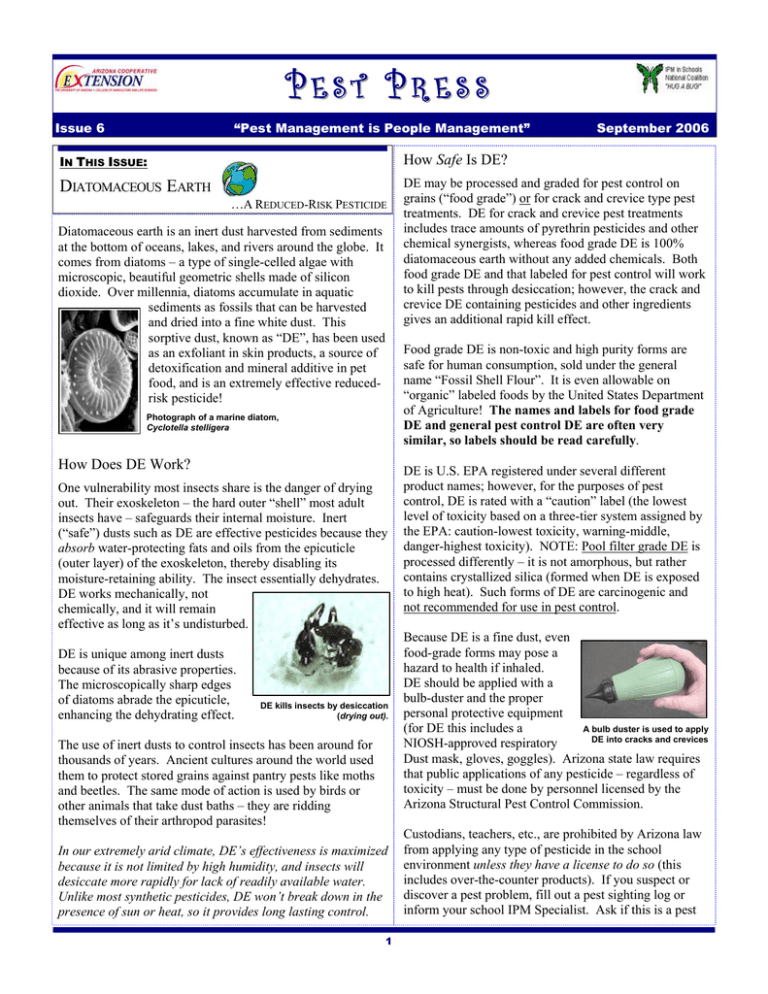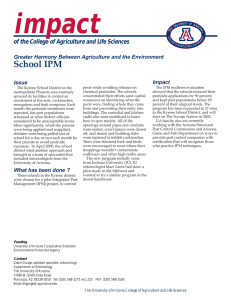P E S
advertisement

PEST PRESS Issue 6 “Pest Management is People Management” September 2006 IN THIS ISSUE: How Safe Is DE? DIATOMACEOUS EARTH DE may be processed and graded for pest control on grains (“food grade”) or for crack and crevice type pest treatments. DE for crack and crevice pest treatments includes trace amounts of pyrethrin pesticides and other chemical synergists, whereas food grade DE is 100% diatomaceous earth without any added chemicals. Both food grade DE and that labeled for pest control will work to kill pests through desiccation; however, the crack and crevice DE containing pesticides and other ingredients gives an additional rapid kill effect. …A REDUCED-RISK PESTICIDE Diatomaceous earth is an inert dust harvested from sediments at the bottom of oceans, lakes, and rivers around the globe. It comes from diatoms – a type of single-celled algae with microscopic, beautiful geometric shells made of silicon dioxide. Over millennia, diatoms accumulate in aquatic sediments as fossils that can be harvested and dried into a fine white dust. This sorptive dust, known as “DE”, has been used as an exfoliant in skin products, a source of detoxification and mineral additive in pet food, and is an extremely effective reducedrisk pesticide! Food grade DE is non-toxic and high purity forms are safe for human consumption, sold under the general name “Fossil Shell Flour”. It is even allowable on “organic” labeled foods by the United States Department of Agriculture! The names and labels for food grade DE and general pest control DE are often very similar, so labels should be read carefully. Photograph of a marine diatom, Cyclotella stelligera How Does DE Work? One vulnerability most insects share is the danger of drying out. Their exoskeleton – the hard outer “shell” most adult insects have – safeguards their internal moisture. Inert (“safe”) dusts such as DE are effective pesticides because they absorb water-protecting fats and oils from the epicuticle (outer layer) of the exoskeleton, thereby disabling its moisture-retaining ability. The insect essentially dehydrates. DE works mechanically, not chemically, and it will remain effective as long as it’s undisturbed. DE is unique among inert dusts because of its abrasive properties. The microscopically sharp edges of diatoms abrade the epicuticle, enhancing the dehydrating effect. DE kills insects by desiccation (drying out). The use of inert dusts to control insects has been around for thousands of years. Ancient cultures around the world used them to protect stored grains against pantry pests like moths and beetles. The same mode of action is used by birds or other animals that take dust baths – they are ridding themselves of their arthropod parasites! In our extremely arid climate, DE’s effectiveness is maximized because it is not limited by high humidity, and insects will desiccate more rapidly for lack of readily available water. Unlike most synthetic pesticides, DE won’t break down in the presence of sun or heat, so it provides long lasting control. 1 DE is U.S. EPA registered under several different product names; however, for the purposes of pest control, DE is rated with a “caution” label (the lowest level of toxicity based on a three-tier system assigned by the EPA: caution-lowest toxicity, warning-middle, danger-highest toxicity). NOTE: Pool filter grade DE is processed differently – it is not amorphous, but rather contains crystallized silica (formed when DE is exposed to high heat). Such forms of DE are carcinogenic and not recommended for use in pest control. Because DE is a fine dust, even food-grade forms may pose a hazard to health if inhaled. DE should be applied with a bulb-duster and the proper personal protective equipment A bulb duster is used to apply (for DE this includes a DE into cracks and crevices NIOSH-approved respiratory Dust mask, gloves, goggles). Arizona state law requires that public applications of any pesticide – regardless of toxicity – must be done by personnel licensed by the Arizona Structural Pest Control Commission. Custodians, teachers, etc., are prohibited by Arizona law from applying any type of pesticide in the school environment unless they have a license to do so (this includes over-the-counter products). If you suspect or discover a pest problem, fill out a pest sighting log or inform your school IPM Specialist. Ask if this is a pest Arizona Children’s Environmental Health Program that could be effectively controlled using DE. What Types of Critters is DE Useful On? DE – both food grade and forms containing additional pesticides – is effective on anything with an exoskeleton. This means insects (anything with six legs) and non-insect arthropods (eight or more legs). Crawling and hiding insect, spider, and scorpion pests will contact crack and crevice treatments, so DE is an excellent option for these areas. As with any pesticide application, effective pest control also involves addressing the root of the problem: why the pests are present in the first place. What’s drawing them in? …Food, water, and shelter. Compliment DE applications with good IPM techniques. For examples, see the “Pest Vulnerable Areas” October 2005 issue of the Pest Press newsletter at http://ag.arizona.edu/urbanipm/index.html. Here are some examples of useful DE applications: Stored product pests: 1. Add food grade (Fossil Shell Flour) DE to stored rice, flour, grains, etc. Fleas and pet parasites: 1. Sprinkle food grade DE into carpet and pet bedding. 2. Work small amounts of food grade DE into your pet’s coat 3. Add food grade DE (according to label) to pet’s water or food as a mineral additive. Unofficial studies indicate DE can help rid pets of internal parasites. Ants, scorpions, and many outdoor pests: 1. Apply DE dry or mixed into water (as per label instructions) to an ant nest hole. The water will carry the DE deep into the nest. When the DE dries out naturally, it will begin to take effect. 2. Use as a dust on your plants to help combat foliage feeders. 3. Use a bulb-duster to apply a very light application around the exterior of your home as a barrier treatment. 4. Use a bulb-duster to apply a light application into cracks and crevices of block walls harboring scorpions, under stucco wall joints, and into hardto-seal corner crevices favored by widow spiders. Indoor, crack and crevice: Note: use food grade DE indoors anywhere children could potentially come into contact. 1. Puff into wall voids to control cockroaches and other occasional invaders. 2. Apply to cracks and crevices with a bulb duster, or other suitable dust application equipment, to manage a wide variety of pests. The next Arizona Children’s Environmental Health Coalition meeting will be on December 7th, 2006, 9 am- noon. Coalition members and interested others are encouraged to invite colleagues (school facilities and administration staff, environmental health advocates, reporters, etc.). Please RSVP to Dawn or Jen. The meeting will include: Management strategies for ROOF RATS Implications of SB1350 - the new law becomes effective January 2007 and governs pesticide use notification in child care and school facilities. District updates, networking opportunities, and more! Orkin Pest ID booklets will be distributed at the meeting. School IPM implementers and advocates from Arizona and at least six other states received grant funding from the Western Regional IPM Center to form a western U.S. school IPM work group! The work group will convene regularly during 2007 to identify obstacles and opportunities with school IPM in the west, explore innovative funding sources, give input on structural IPM training curricula, and “test drive” school IPM resources UA staff developed with input from national programs. Things you might see around Arizona in Sept/Oct… Ants, particularly southern fire ants, are still busy! Horse lubber grasshoppers in the Tucson area, even around town! Migrating bats! Learn more about bats and their habitat at Bat Conservation International: http://www.batcon.org/home. Tarantulas (males) out and about looking for females. If you see them while out hiking don’t impede their mission. Appreciate and observe this amazing creature Tarantula after a monsoon. Arizona is lucky to boast! Photo by UA faculty Bill Shaw Information taken from: California Academy of Sciences website: http://www.calacademy.org/research/diatoms/index.html Environmental Protection Agency website, Pesticides: Regulating Pesticides, http://www.epa.gov/pesticides/biopesticides/ Eureka: Diatoms Nature’s Gems website: http://hjs.geol.uib.no/Diatoms/index.html-ssi Olkowski, William, Sheila Daar, Helgo Olkowski. Common Sense Pest Control. The Taunton Press, 1991. 715 pp. Quarles, William, Peter S. Winn. The IPM Practitioner. January-February 2006. vol. XXIII. Bio-integral Resource Center. Berkeley, CA. For information on Arizona’s IPM in Schools program contact Dawn Gouge or Jennifer Snyder 520-568-2273, dhgouge@ag.arizona.edu Few bugs are bad! More than 95% of all insect species are beneficial to humans 2




